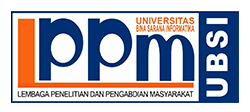Folklor dan Peningkatan Pengalaman Wisata di Gunung Tangkuban Parahu
Sari
Kata Kunci
Teks Lengkap:
PDFReferensi
Andreas, L., & Dimanche, F. (2014). Co-creation on Experience Value: A Tourist Behaviour Approach. In N. K. Prebensen, J. S. Chen, & M. Uysal (Eds.), Creating Experience Value in Tourism2 (pp. 95–112). CABI International.
Anoegrajekti, N., Saryono, D., & Putra, I. N. D. (Eds.). (2020). Sastra Pariwisata. PT Kanisius (Anggota IKAPI).
Brahmantyo, B., & Bachtiar, T. (2009). Wisata Bumi Cekungan Bandung. Truedee Pustaka Sejati.
Bruner, E. M. (2001). The Maasai and the Lion King: Authenticity, Nationalism, and Globalization in African Tourism. American Ethnologist, 28(4), 881–908. https://doi.org/10.1525/ae.2001.28.4.881
Boratti, V. M. (2019). Folklore and the Civilizing Gaze of Modernity: An Indian Folklorist in Colonial Karnataka. Folklore (United Kingdom), 130(3), 300–310. https://doi.org/10.1080/0015587X.2019.1605735
Chen, J. S., Prebensen, N. K., & Uysal, M. (2014). Dynamic Drivers of Tourist Experiences. In N. K. Prebensen, J. S. Chen, & M. Uysal (Eds.), 2Creating Experience Value in Tourism (pp. 11–20). CABI International.
Citraningtyas, C. E., & Darminto, K. V. (2020). Advancement of Folktale Tourism By Folktale Reconstruction : a Proposed Model Focused on Indonesia and Japan. Asian Journal of Arts Culture and Tourism, 1(2), 1–8. http://103.8.145.246/index.php/ajact/article/view/8290
Cornelisse, M. (2014). Memorable tourist experiences in authentic Vicos, Peru. Journal of Tourism Consumption and Practice, 6(1).
Creswell, J. W. (2014). Research Design: Qualitative, Quantitative, and Mixed Methods Approaches (4th ed.). SAGE Publications.
Croce, R. Della, Elmi, B., Fioretti, C., & Smorti, A. (2018). Visit to an Unknown City: Exploring Children’s Fictional Narratives About a Tourist Experience. The Open Psychology Journal, 11(1), 148–162. https://doi.org/10.2174/1874350101811010148
Cui, Q., Liao, X., & Xu, H. (2017). Tourist experience of nature in contemporary China: a cultural divergence approach. Journal of Tourism and Cultural Change, 15(3), 248–264. https://doi.org/10.1080/14766825.2015.1113981
Danandjaja, D. (2015). Folklor Indonesia: Ilmu Gosip, Dongeng dan lain-lainnya. In Indonesian folklore: gossip science, folktale, and others. Graffiti.
Dancey, C., & Reidy, J. (2017). Statistics without Maths for Psychology (7th ed.). Pearson.
Fajardin, M. A. (2021). Sandiaga Ungkap Potensi Wisata Berbasis Cerita Rakyat. Sindonews.Com2.
Feldman, E. B. (1967). Art as Image and Idea. Prentice-Hall Inc.
Finardi, A. D. I., & Yuniawati, Y. (2016). Pengaruh Customer Experience Terhadap Revisit Intention Di Taman Wisata Alam Gunung Tangkuban Perahu. Tourism and Hospitality Essentials (THE) Journal, 6(1), 983–994.
Gamil, R. El. (2017). Storytelling as a Tool for Safeguarding and Marketing the Intangible Cultural Heritage (ICH): The Case of Nubia City, Egypt. Journal of Tourism Research, 18(November), 165–185.
Hajra, V. (2015). Role of Indian Folk Culture in Promotion of Tourism in the Country. PARIPEX: Indian Journal of Research, 4(2), 231–235.
Harini, Y. N. A. (2018). The Use of Legend in Tourism: Case Study of Si Pitung from Indonesia. 231(Amca), 445–447. https://doi.org/10.2991/amca-18.2018.123
Harun, H., Alwi, A., Othman, A., & Annamalai, S. (2019). Safeguarding Malaysian Folktale through Adventure Game for Teenager [Universiti Utara Malaysia]. https://doi.org/10.17576/JKMJC-2019-3502-27
Hemme, D. (2005). Landscape, fairies and identity: Experience on the backstage of the fairy tale route. Journal of Tourism and Cultural Change, 3(2), 71–87. https://doi.org/10.1080/09669580508668488
Heriyanto, Manggong, L., & Sujatna, E. T. S. (2020). Linguistic Constructions as Cognitive Representations in Metaphors of Tourism Advertorials: A Case Study on Indonesian Tourism Promotion. American Journal of Humanities and Social Sciences REsearch, 4(1), 182–187.
Hodsdon, L. (2020). ‘I expected … something’: imagination, legend, and history in TripAdvisor reviews of Tintagel Castle. Journal of Heritage Tourism, 15(4), 410–423. https://doi.org/10.1080/1743873X.2019.1664558
Inderasari, E., & Kurniasih, D. (2019). The Preservation of Various Joko Tingkir Stories as The Strategy of Developing Folklore-Based Tourism. Sarjana-Kesusastraan Indonesia, 25–40.
Ironside, R. (2018). The allure of dark tourism : legend tripping and ghost seeking in dark places . In D. Waskul & M. Eaton (Eds.), The Supernatural in Society, Culture and History (pp. 95–115). Temple University Press [online].
Ironside, R., & Massie, S. (2020). The folklore-centric gaze: a relational approach to landscape, folklore and tourism. Time and Mind, 00(August), 227–244. https://doi.org/10.1080/1751696X.2020.1809862
Jayawati, M. T., Atisah, & Subardini, N. N. (2003). Cerita Rakyat dan Objek Pariwisata di Indonesia Teks dan Analisis Latar. Pusat Bahasa Departemen Pendidikan Nasional.
Jordan, P. (2014). The Modern Fairy Tale : Nation Branding, National Identity and the Eurovision Song Contest in Estonia. In Eva-Clarita Pe (Ed.), Politics and Society in the Baltic Sea Region. University of Tartu Press. https://doi.org/10.26530/oapen_474310
Kartika, T., & Riana, N. (2020). Storynomics Tourism as an Effective Marketing Strategy on Tourism Destination (Case Study on Tangkuban Parahu, West Java-Indonesia). Tourism and Sustainable Development Review, 1(1), 33–40. https://doi.org/10.31098/tsdr.v1i1.8
KBBI. (n.d.). Folklore. Kamus Besar Bahasa Indonesia. Retrieved 2 February 2021, from https://kbbi.web.id/folklor
Kropej, M. (2014). Narrative Tradition About King Matthias. Ethnology Slovak, 62(2).
Kutin, B. I., & Telban, M. K. (2018). Preservation of intangible cultural heritage through local legends of place. Traditiones, 47(3), 103–115. https://doi.org/10.3986/Traditio2018470307
Kutin, B. I., & Telban, M. K. (2021). Legends of places as part of the sustainable development of regions. Folklore (Estonia), 81, 157–178. https://doi.org/10.7592/FEJF2021.81.ivancic_kropej
Lee, T. H., & Jan, F.-H. (2022). How does tourism image affect visitor perceptions of a festival’s identity? Influence analysis of three aboriginal festivals in Taiwan. Journal of Destination Marketing & Management, 24(June 2021), 100704. https://doi.org/10.1016/j.jdmm.2022.100704
Lovell, J., & Griffin, H. (2019). Fairy tale tourism: the architectural projection mapping of magically real and irreal festival lightscapes. Journal of Policy Research in Tourism, Leisure and Events, 11(3), 469–483. https://doi.org/10.1080/19407963.2018.1556674
MacLeod, N., Shelley, J., & Morrison, A. M. (2018). The touring reader: Understanding the bibliophile’s experience of literary tourism. Tourism Management, 67, 388–398. https://doi.org/10.1016/j.tourman.2018.02.006
Mathisen, L. (2012). The exploration of the memorable tourist experience. In Advances in Hospitality and Leisure (Vol. 8, Issue 2012). Emerald Group Publishing Ltd. https://doi.org/10.1108/S1745-3542(2012)0000008006
Michalopoulos, S., & Xue, M. M. (2021). Folklore. The Quarterly Journal of Economics, 1–54. https://doi.org/10.1093/qje/qjab003
Moric, A., & Lewis, A. P. (2018). Petar klepac/Peter klepec/Pitr kljepc: A borderland hero and the manifestations of his strength. Narodna Umjetnost, 55(1), 135–158. https://doi.org/10.15176/vol55no108
Moscardo, G. (2020). Stories and design in tourism. Annals of Tourism Research, 83(May), 102950. https://doi.org/10.1016/j.annals.2020.102950
Mossberg, L., Therkelsen, A., H. Huijbens, E., Björk, & Anna-Karin Olsson, P. (2010). Storytelling and Destination Development. Nordic Innovation Centre (NICe) Project Number: 08041 Authors:, December, 1–65.
Muakhir, A. (2014). Dayang Sumbi yang Pintar dan Sanggkuriang. In Kumpulan Cerita Rakyat Edisi 2 (2nd ed., p. 150). Serambi Ilmu Semesta.
Peraturan Daerah Provinsi Jawa Barat Nomor 15 Tahun 2015 tentang Rencana Induk Pembangunan Kepariwisataan Provinsi Jawa Barat Tahun 2015-2025. (n.d.).
Picard, M. (2006). Bali and Beyond. Explorations in the Anthropology of Tourism, Shinji Yamashita. Moussons, 9–10, 376–377. https://doi.org/10.4000/moussons.1947
Pike, S. (2008). Destination Marketing : An Integrated Marketing Communication Approach.
Pine, B. J., & Gilmore, J. H. (1999). The Experience Economy: Work is Theatre and Every Business is a Stage. HBS Press.
PPID Kota Bandung. (n.d.). Legenda Sangkuriang: Asal Gunung Tangkuban Perahu. PPID Kota Bandung. Retrieved 11 March 2021, from https://ppid.bandung.go.id/knowledgebase/legenda-sangkuriang-asal-gunung-tangkuban-perahu/
Rengganis, I. (2017). Analisis Gambar Karya Anak Usia Dini. Jurnal Ilmu Pendidikan, 5(1).
Roodenburg, H. (2002). Making an island in time: Dutch folklore studies, painting, tourism, and craniometry around 1900. Journal of Folklore Research, 39(2/3), 153–159. https://doi.org/10.2979/JFR.2002.39.2-3.173
Sari, I. A. L., & Listiani, W. (2019). Promoting Japanese Cultural Tourism through Appreciation of Ainu Folktales and Anime. International Conference on Fundamental and Applied Research (I_CFAR), November.
Sävborg, D., & Valk, Ü. (2018). Place-lore, Liminal Storyworld and Ontology of the Supernatural. An Introduct... Helsinki: Suomalaisen Kirjallisuuden Seura (Studia Fennica Folkloristica; 23). Related.
Servidio, R., & Ruffolo, I. (2016). Exploring the relationship between emotions and memorable tourism experiences through narratives. Tourism Management Perspectives, 20, 151–160. https://doi.org/10.1016/j.tmp.2016.07.010
Shortlidge, J., & Jones, M. O. (1995). Putting Folklore to Use. In The Journal of American Folklore (Vol. 108, Issue 428). https://doi.org/10.2307/541384
Slater, C. (2011). Geoparks and Geostories: Ideas of Nature Underlying the UNESCO Araripe Basin Project and Contemporary ‘Folk’ Narratives. Latin American Research Review, 46(S), 159–183. https://doi.org/10.1353/lar.2011.0037
Sofield, T., Guia, J., & Specht, J. (2017). Organic ‘folkloric’ community driven place-making and tourism. Tourism Management, 61, 1–22. https://doi.org/10.1016/j.tourman.2017.01.002
Starčević, L. (2019). Fairy tale tourism: Expectation and experiences of different age groups in Ivana’s House of Fariry Tales. University Tom Sintobin.
Sthapit, E. (2018). A netnographic examination of tourists’ memorable hotel experiences. Anatolia, 29(1), 108–128. https://doi.org/10.1080/13032917.2017.1402190
Sthapit, E., & Coudounaris, D. N. (2018). Memorable tourism experiences: antecedents and outcomes. Scandinavian Journal of Hospitality and Tourism, 18(1), 72–94. https://doi.org/10.1080/15022250.2017.1287003
Sunarti, S. (2020). Pemberdayaan Cerita Rakyat untuk Pengembangan Destinasi Wisata. In Novi Anoegrajekti, D. Saryono, & I. N. D. Putra (Eds.), Sastra Pariwisata (pp. 46–72). PT Kanisius.
Supriadi, A. (2012). Kearifan Lokal Cerita Sangkuriang: Menuju Ketahanan Bangsa. METASASTRA, 5(1), 1. https://doi.org/10.26610/metasastra.2012.v5i1.1-10
Tsai, T. H., & Chen, C. M. (2019). Evaluating tourists’ preferences for attributes of thematic itineraries: Holy folklore statue in Kinmen. Tourism Management Perspectives, 30(February), 208–219. https://doi.org/10.1016/j.tmp.2019.02.010
TWA Tangkuban Parahu. (n.d.). Legenda Sangkuriang: Cerita Rakyat. Taman Wisata Alam Tangkuban Parahu. Retrieved 12 February 2022, from https://twatangkubanparahu.com/legenda-sangkuriang/
UNESCO. (n.d.). Oral traditions and expressions including language as vehicle of the intangible cultural hertage. UNESCO Headquarters. Retrieved 14 February 2021, from https://ich.unesco.org/en/oral-traditions-and-expressions-00053
UNESCO. (2003). The Convention for the Safeguarding of the Intangible Cultural Heritage. UNESCO. https://ich.unesco.org/en/convention
Wakik, A. K. (2021). Menparekraf: Cerita Rakyat Bisa Jadi Nilai Tambah Pariwisata. RMOL.ID. https://politik.rmol.id/read/2021/02/21/476020/menparekraf-cerita-rakyat-bisa-jadi-nilai-tambah-pariwisata
Wei, C., Zhao, W., Zhang, C., & Huang, K. (2019). Psychological factors affecting memorable tourism experiences. Asia Pacific Journal of Tourism Research, 24(7), 619–632. https://doi.org/10.1080/10941665.2019.1611611
Yunxia, W. (2019). The Symbols of Folklore Tourism Culture of the Waterside Residents in Hainan and Its Dissemination and Development. 3rd International Workshop on Arts, Culture, Literature and Language (IWACLL 2019) The, IWACLL, 285–289. https://doi.org/10.25236/iwacll.2019.062
Zhang, Q., & Xu, H. (2020). Understanding aesthetic experiences in nature-based tourism: The important role of tourists’ literary associations. Journal of Destination Marketing and Management, 16(March), 100429. https://doi.org/10.1016/j.jdmm.2020.100429
DOI: https://doi.org/10.31294/khi.v15i1.16228
====================================================================
Terbit setiap bulan Maret & September, ISSN : 2655-5433 (online)














